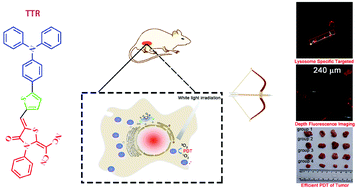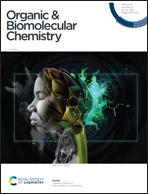A lysosome-targeted near-infrared photosensitizer for photodynamic therapy and two-photon fluorescence imaging†
Abstract
Organelle-targeted two-photon near-infrared photosensitizers are highly desirable for photodynamic therapy (PDT) of cancer. Herein, in this contribution, we have developed a 2-dicyanomethylenethiazole-based D–π–A structured near-infrared photosensitizer (TTR). TTR exhibits near-infrared emission (704 nm), a large Stokes shift (200 nm), and smaller ΔES1–T1 (the energy gap between S1 and T1) (0.717 eV). In vitro results show that TTR can specifically target lysosomes in living cells for near-infrared fluorescence imaging. With efficient ROS generation, excellent biocompatibility, two-photon imaging capability, and depth imaging (21 μm in vitro and 210 μm in vivo), TTR can effectively kill tumor cells and inhibit the growth of subcutaneous tumors. The hematoxylin–eosin (H&E) staining and blood biochemical parameter results further prove the biocompatibility of TTR. Hence, TTR can be a promising photosensitizer for PDT.

- This article is part of the themed collection: Chemical Biology in OBC


 Please wait while we load your content...
Please wait while we load your content...